Sony’s Xperia Z smartphone, which went on sale in February, has already sold almost 1 million units by some estimates. However, NTT DoCoMo, Japan’s largest mobile carrier, will soon stop selling it.
The Xperia Z has not even hit the US market yet — T-Mobile says the model will make its debut on its network in the coming weeks — but it is already a has-been in Japan. DoCoMo has turned its attention to a new phone, the Sony Xperia A — a model with fewer features that has not won the stellar praise showered on the Z.
“It’s time for a new model,” said Mai Kariya, a DoCoMo representative in Tokyo. “We’re finished with the Xperia Z and now focusing on the Xperia A.”
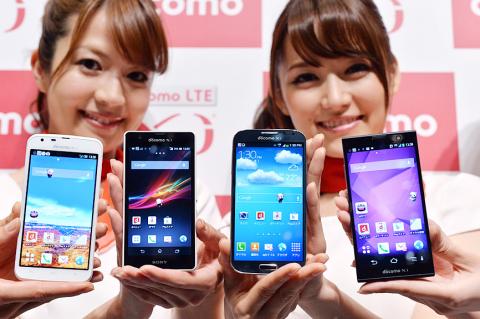
Photo: AFP
As Sony banks on smartphones to turn around its struggling electronics business, it faces an increasingly bothersome obstacle at home: the demands of Japan’s powerful cellphone carriers, which remain obsessed with constant model updates.
For years, Japan’s three largest mobile network companies have pressed phone makers to update their handsets every three or four months, providing Japanese consumers with a dazzling array of newfangled phones and features each season.
Phones with digital TV broadcast receivers were once all the rage; a phone without it was never going to sell. Then it was thumbprint scans; you would be hard pressed to find those on many phones today. The same is true of swiveling screens, and to a lesser extent, electronic wallets.
SHORT RUNS
The fast-paced cycle is commonplace in Japanese marketing. Manufacturers deliver short runs of seasonal products to create buzz, analysts say. Pepsi Japan, for example, brings out limited-edition drinks each year: Salty Watermelon Pepsi or Pepsi Ice Cucumber. Nestle’s KitKat candy bar has cycled through an eye-popping array of limited editions in Japan: green tea, pumpkin, strawberry cheesecake, wasabi and soybean, to name only a few.
Even Japan’s best-selling pop group, AKB48, rotates through a cast of 67 members and on New Year’s Day released 16 versions of new and repackaged records.
“This is the worst of Japanese companies’ excessive obsession with the new,” said Yuichi Kogure, an associate professor in information technology policy at Aomori Public University and the author of several books on Japan’s cellphone industry. “But now the mobile phone makers are exhausted.”
Sony’s Xperia Z got caught in this marketing buzz-saw. DoCoMo started selling the Xperia Z in Japan on Feb. 9 as part of the carrier’s spring collection, replacing the Xperia AX of the winter collection last year. Barely a month later, on March 15, DoCoMo announced its summer collection of 11 new phones, with the Xperia Z replaced by the Xperia A, which went on sale last month.
The constant feature roulette has helped carriers lure customers away from rival networks, but it taxes the research and development resources of Japan’s phone makers, who must meet the constant demands from carriers for new high-end features and frequent handset renewals.
Not every maker succumbs to this whirligig and, not surprisingly, those that do not are not Japanese. Apple has announced a new iPhone model roughly once a year. Its iPhone 5 came out in September, and the company is not expected to introduce a new model until the fall. Samsung Electronics is focusing its resources on its sleek Galaxy S4 smartphone, which went on sale in April, a full year after its predecessor the Galaxy S3.
The scattershot efforts by Japanese handset designers could not compete with a single blockbuster product like Apple’s iPhone, Kushida said.
It turned out that Japanese consumers did not want a new phone each season after all, but one very well-designed one, he said.
Since its release in 2008, the iPhone has been a best-seller in Japan, becoming the most popular handset in the country. Last year, the iPhone led all handsets with an overall market share of 15 percent, ahead of former market leaders Sharp and Fujitsu, according to market researcher International Data Corp Japan.
Looking at smartphones only, Apple’s dominance in Japan is even stronger: For the first three months of the year, Apple’s mobile platform market share came to 49.2 percent, compared with Android’s 45.8 percent, according to Kantar WorldPanel, which tracks mobile phone sales in major markets.
Sony’s Xperia Z, which runs on the Android operating system, was shaping up to be Japan’s greatest challenger to the iPhone and to another global blockbuster, Samsung’s Galaxy series. The Xperia Z won rave reviews for its sleek aluminum case, sharp 5-inch display, fast-capture camera and high-definition video.
The Xperia Z has topped sales charts, selling at least 630,000 units in Japan in its first 10 weeks, according to the data provider, GfK Japan. DoCoMo had said that it aimed to sell about 1 million units in Japan, and analysts agree that sales are approaching that number. Sony chief executive Kazuo Hirai has repeatedly promoted the Xperia Z’s strong sales in Japan as one of the few bright spots in its money-losing electronics sector.
Still, production of the Xperia Z has ceased for the Japanese market, and the model will no longer be available in Japan once stock runs out at retail stores across the country, both Sony and NTT DoCoMo said.
“The Japanese market operates on a far quicker life cycle than markets overseas,” said Yu Tominaga, a Sony spokesman in Tokyo. “Demand changes fast here, but we are set up to respond to that.”
GLOBAL STRATEGY
The big question is whether Sony can develop a coherent global smartphone strategy without being distracted by the ever-changing needs of its home market. A lot rides on Sony’s gaining on its archrivals, Apple and Samsung, in the fast-growing smartphone market with the new Xperia A, which has been topping sales charts here since it went on sale in the middle of last month.
Sony is starting to shift its focus beyond Japan’s shores. On Tuesday in China it announced the Xperia Z Ultra, which Sony bills as the slimmest large-screen handset on the market. The company said it was not sure when that model might sell in Japan.
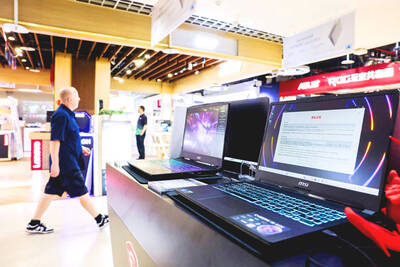
IN THE AIR: While most companies said they were committed to North American operations, some added that production and costs would depend on the outcome of a US trade probe Leading local contract electronics makers Wistron Corp (緯創), Quanta Computer Inc (廣達), Inventec Corp (英業達) and Compal Electronics Inc (仁寶) are to maintain their North American expansion plans, despite Washington’s 20 percent tariff on Taiwanese goods. Wistron said it has long maintained a presence in the US, while distributing production across Taiwan, North America, Southeast Asia and Europe. The company is in talks with customers to align capacity with their site preferences, a company official told the Taipei Times by telephone on Friday. The company is still in talks with clients over who would bear the tariff costs, with the outcome pending further
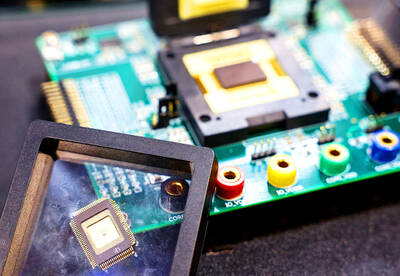
NEGOTIATIONS: Semiconductors play an outsized role in Taiwan’s industrial and economic development and are a major driver of the Taiwan-US trade imbalance With US President Donald Trump threatening to impose tariffs on semiconductors, Taiwan is expected to face a significant challenge, as information and communications technology (ICT) products account for more than 70 percent of its exports to the US, Chung-Hua Institution for Economic Research (CIER, 中華經濟研究院) president Lien Hsien-ming (連賢明) said on Friday. Compared with other countries, semiconductors play a disproportionately large role in Taiwan’s industrial and economic development, Lien said. As the sixth-largest contributor to the US trade deficit, Taiwan recorded a US$73.9 billion trade surplus with the US last year — up from US$47.8 billion in 2023 — driven by strong
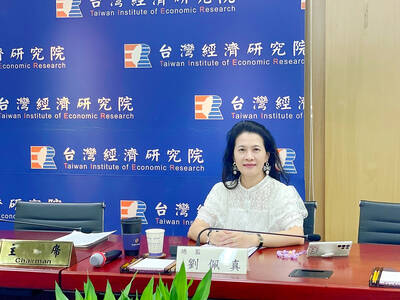
A proposed 100 percent tariff on chip imports announced by US President Donald Trump could shift more of Taiwan’s semiconductor production overseas, a Taiwan Institute of Economic Research (TIER) researcher said yesterday. Trump’s tariff policy will accelerate the global semiconductor industry’s pace to establish roots in the US, leading to higher supply chain costs and ultimately raising prices of consumer electronics and creating uncertainty for future market demand, Arisa Liu (劉佩真) at the institute’s Taiwan Industry Economics Database said in a telephone interview. Trump’s move signals his intention to "restore the glory of the US semiconductor industry," Liu noted, saying that
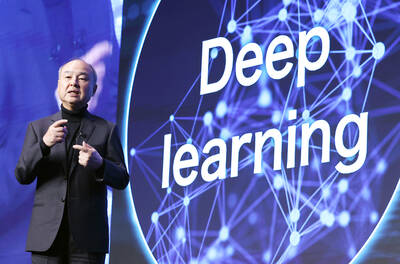
AI: Softbank’s stake increases in Nvidia and TSMC reflect Masayoshi Son’s effort to gain a foothold in key nodes of the AI value chain, from chip design to data infrastructure Softbank Group Corp is building up stakes in Nvidia Corp and Taiwan Semiconductor Manufacturing Co (TSMC, 台積電), the latest reflection of founder Masayoshi Son’s focus on the tools and hardware underpinning artificial intelligence (AI). The Japanese technology investor raised its stake in Nvidia to about US$3 billion by the end of March, up from US$1 billion in the prior quarter, regulatory filings showed. It bought about US$330 million worth of TSMC shares and US$170 million in Oracle Corp, they showed. Softbank’s signature Vision Fund has also monetized almost US$2 billion of public and private assets in the first half of this year,